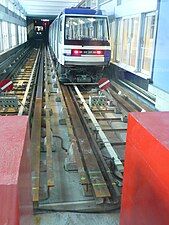Roll way
Appearance
(Redirected from Running pad)
A roll way or running pad is the pad placed on a concrete slab or on the ties on the outside of the 1,435 mm (4 ft 8+1⁄2 in) conventional track along both running rails of a rubber-tyred metro or along the unconventional track of a tram. The rubber-tyred wheels roll directly on the roll ways.
- With a conventional track:
- The ones of the Montreal Metro are precast concrete on a concrete slab.
- The ones of the Paris Métro are H-steel on ties.
- The ones of the Mexico City Metro are H-steel.
- The ones of the Santiago Metro are precast concrete below ground and H-steel above ground.
- The ones of the Lausanne Métro Line M2 are H-steel.
- The ones of the Lyon Metro (lines A, B and D) are H-steel.
- Without a conventional track:
- The ones of the Lille Metro are precast concrete.
- The ones of the Toulouse Metro are precast concrete.
- The ones of the Sapporo Municipal Subway are flat steel with a central guide rail.
- Busan Subway Line 4 runs directly on a concrete slab between guide bars.
- Many people mover systems, such as Crystal Mover, run directly on concrete slabs or other surfaces between guide bars.
- Some guided buses, rubber-tyred trams, such as Translohr and Bombardier Guided Light Transit, use concrete slabs while being guided by a single central rail.
Gallery
[edit]-
View of a track from a sand drag, in the Montreal Metro near the Beaugrand Station, showing the cross-section of guide bars, precast concrete roll ways and conventional track
-
Lausanne Métro Line M2, showing the angle iron guide bars and the I-beam roll ways as well as bumper posts
-
Lille Metro line 1 near Quatre Cantons Workshop, the absence of conventional rail for guidance at junctions is compensated by a central stub guide rail.
See also
[edit]- The technology of rubber-tyred metros
- Translohr, uses rollways
External links
[edit]- Visual dictionary
- Rail system
- VAL "Documentation technique du VAL 206 [dont le VAL 208 en est l'évolution]" (PDF). traction-electrique.ch (in French). Retrieved 7 February 2023.



